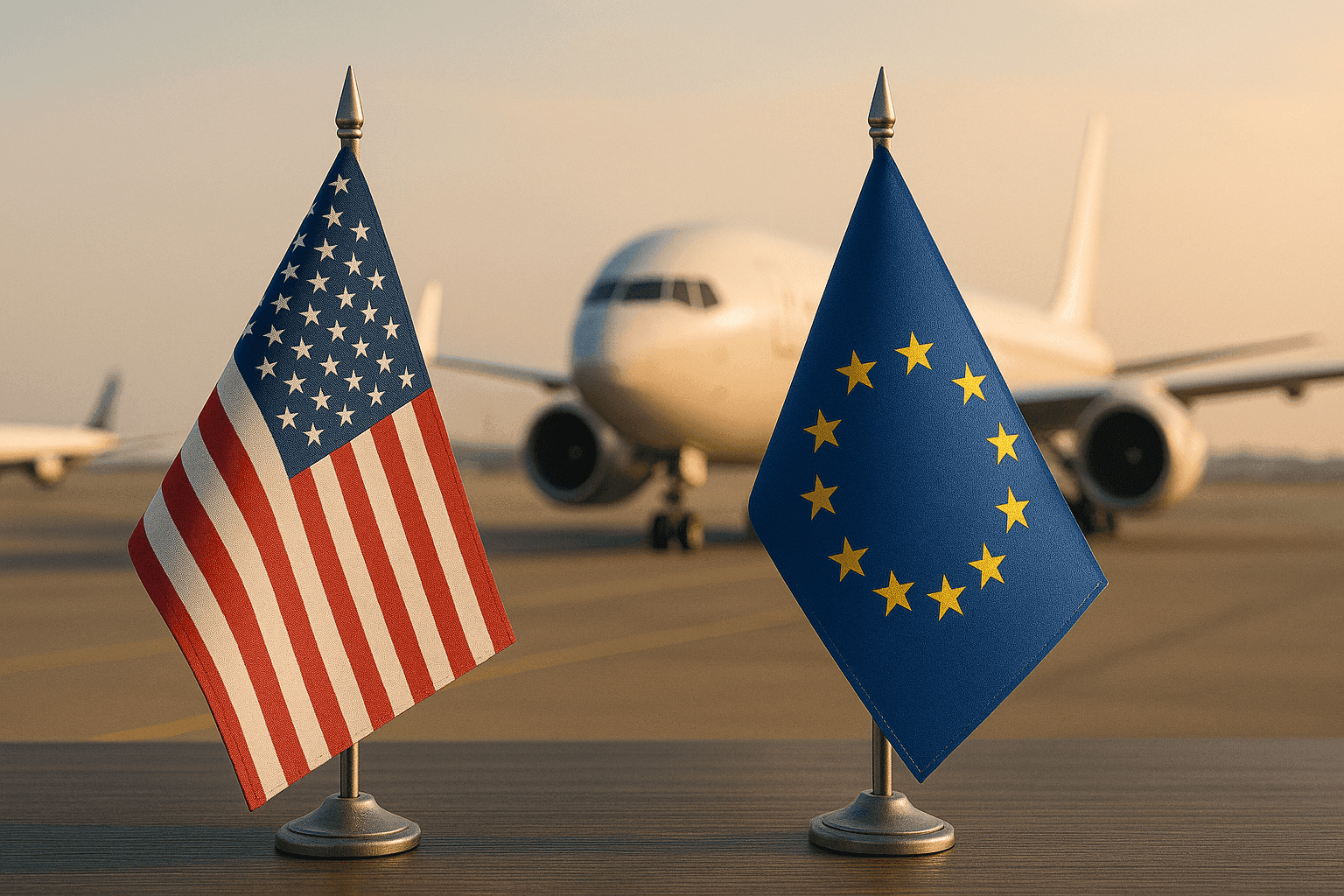New Altitude: What the EU-US Trade Agreement Means for the Aerospace Industry
The removal of tariffs on key aerospace goods marks more than a policy shift. It reopens transatlantic trade, boosts supplier margins, and creates fertile ground for the next wave of aviation partnerships and innovation.
- Home /
- EU-US Tariff Deal: What Companies Need to Prepare for Starting Today /
- Aerospace: Zero Tariffs, Full Thrust Ahead
Open Skies, Open Opportunity
As of 1 August 2025, a landmark trade agreement between the European Union and the United States will eliminate tariffs on a range of strategic industrial goods. The agreement, signed in late July, marks a significant step in transatlantic economic cooperation.
This “zero-for-zero” agreement is a significant and welcome step forward. As a Partner at H&Z Management Consulting with a sectoral focus on Aerospace and Defence, I see this as a transformative moment for manufacturers, suppliers, and airlines alike, one that will shape strategic decisions for years to come.
Zero-for-Zero: What’s Included?
The headline: aircraft, jet engines, and selected aerospace components will no longer be subject to import tariffs when traded between the EU and the US.
This includes:
- Complete civil aircraft, including large passenger and cargo jets;
- Jet engines, whether for commercial or regional aircraft;
- Tier-1 components, such as avionics systems, landing gear, and cabin interiors;
Selected materials and assemblies used in manufacturing, such as high-grade aluminium or composite parts.
By eliminating these tariffs, the agreement revives the spirit of open aerospace trade, while providing clarity and cost relief to companies operating across both regions.
Boost for Tier-1 Suppliers
Equally important are the implications for Tier-1 suppliers, companies that deliver critical subsystems to aircraft OEMs. These include names like Liebherr, Diehl, and Safran. For these firms, the deal offers two key advantages:
- Margins: Duty-free exports of aircraft electronics, interiors, and structures will foster transatlantic trade in both directions and enhance margins on transatlantic programmes.
- Operational simplicity: supply chains that span the Atlantic, as is often the case in aerospace, will be smoother, less burdened by compliance costs, and less vulnerable to protectionist policy shifts.
From an industry consulting point of view, this frees up valuable capital. Instead of allocating resources to navigating tariffs or restructuring production to avoid them, firms can now redirect investment into innovation and cross-border collaboration.
Enabling Transatlantic Aerospace Cooperation
The deal also signals a reset in EU-US aerospace cooperation. Many existing joint ventures, from CFM International (Safran-GE) to cabin systems partnerships, will benefit from improved trade conditions and greater predictability.
Moreover, this creates fertile ground for new collaborations. Companies that may have been hesitant to enter transatlantic ventures due to tariff risk will now find a more stable environment for joint development, R&D sharing, and cross-market expansion.
Aerospace is inherently global. Removing artificial barriers strengthens its innovation ecosystem. And as a consultancy with deep sector experience, H&Z sees this as an opportunity for our clients to re-evaluate their international partnership strategies, potentially accelerating global go-to-market timelines.
Implications for Airlines and Passengers
This development promotes healthy competition. Airlines can now choose the best aircraft for their fleet without tariff distortion, meaning product performance, reliability, fuel efficiency, and lifecycle cost will dictate market outcomes, not customs policy.
A Broader Industrial Signal
While the aerospace implications are substantial, this trade agreement also signals something larger: a renewed commitment to transatlantic industrial partnership. In times of geopolitical and economic fragmentation, it is both rare and encouraging to see two major blocs align on open trade in strategic technologies.
For Europe, and especially for Germany and France, this alignment supports high-value industrial clusters. It reinforces the idea that advanced manufacturing has a future in Europe, and that European engineering excellence remains globally competitive when given fair access to markets.
At H&Z, we are frequently called upon to help clients in the industry navigate complex global dynamics. This agreement validates a core tenet of our strategic advice: long-term industrial resilience is best built on open markets, diversified partnerships, and smart regulatory alignment.
What Comes Next?
While the agreement is an important milestone, it is also a catalyst. Now is the time for aerospace firms, both OEMs and suppliers, to reassess their strategy in light of this new reality. Questions to consider:
- How should cross-border manufacturing footprints evolve?
- What new EU-US collaboration models now make sense?
Where can supply chain optimisation yield new value under tariff-free conditions?
At H&Z, we are already helping clients explore these questions and design next-generation strategies that leverage the deal’s full potential. For companies ready to act, the competitive window is wide open but not indefinitely.
Final Thoughts
This trade agreement is not just an economic arrangement. It is a statement of intent that the EU and the US are committed to a cooperative, forward-looking industrial relationship.
From Airbus in Toulouse to a cabin electronics supplier in Bavaria to a jet engine assembler in Ohio, the message is clear: the transatlantic sky is open again. Let us use this opportunity to fly higher together.

